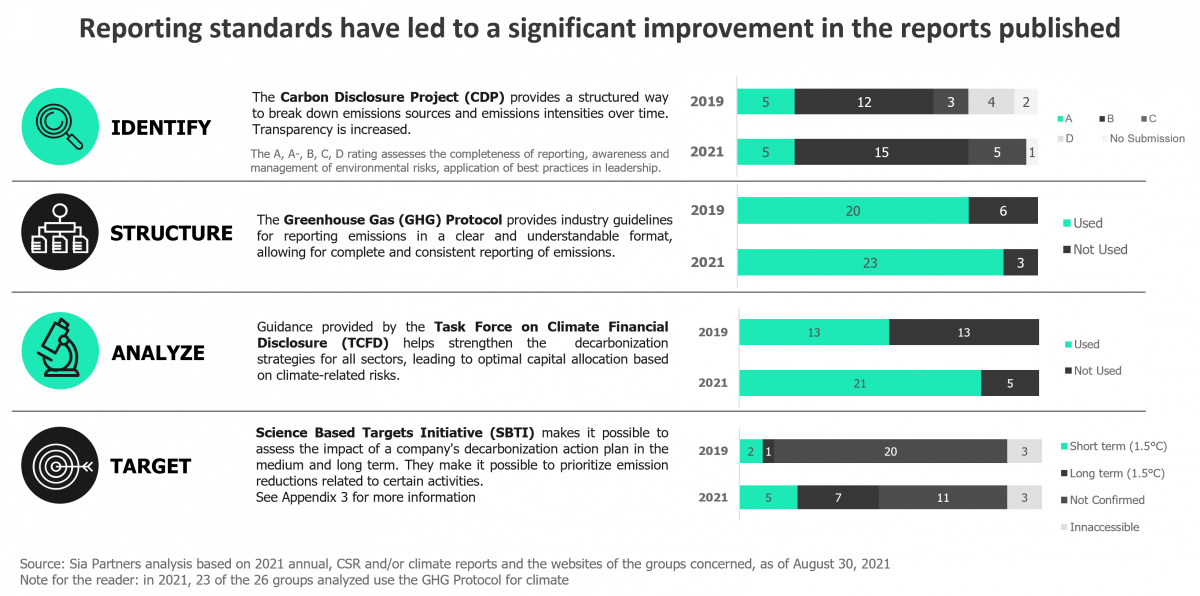Carbon Accounting Management Platform Benchmark…

The climate policies of major European groups are clearly improving but still fail to meet the challenges with the necessary ambition and resources.
In 2018, the European Union set itself the goal of becoming carbon neutral by 2050. Since then, more and more companies from around the continent have been communicating their commitments to contribute to this ambition.
In this second edition of our study on the Climate Policies of Major European Companies, we analyse the publications of 26 European companies. The following questions are addressed in this study; What do groups publish (or not publish) in their reporting? How is their climate strategy constructed? What do their action plans demonstrate (or fail to demonstrate)?

Together the 26 selected groups must eliminate more than 4.5 billion tonnes of CO2, which is almost as much as the emissions of the United States in 2021, the world's second largest emitter.

Climate reporting is gradually becoming clearer and more comprehensive, but there is still a way to go for scope 3 emissions
Increased use of the various international reporting standards (CDP, GHG, TCFD, SBTI) has improved data access, clarity of reporting, completeness, and comparability. 60% of the companies analysed are now using the TFCD compared to 2020.

On the other hand, scope 3 emissions (indirect emissions other than those related to energy consumption) are not reported in a sufficiently exhaustive manner in relation to the CDP's sectoral recommendations. However, they account for an average of 90% of the emissions of large European groups. Only 5 of the 26 companies analysed measure their scope 3 emissions exhaustively.
Behind this blind spot are two major elements, owing to their quantitative importance but also to the increased responsibility they involve: emissions linked to the use of products sold (74% of scope 3 emissions) and emissions linked to products and services purchased by the company (8%).
Climate strategies are becoming more structured, but there is still a lack of vision and accountability among leaders
All the companies analysed mention climate in their strategy. However, the way in which the climate strategy is integrated into the company's overall strategy is still marked by a structural weakness: climate is too often a "side issue", an "add-on" to the overall strategy.
Their objectives are becoming more ambitious but cover partial perimeters: indicators, activities or geographical areas excluded from the defined objectives, and are rarely translated into concrete terms for managers. The objectives are distant, and performance is not assessed through them.
Finally, despite scientific papers and criticism from civil society, the notion of 'carbon neutrality' is almost systematically misused in communications.

Note: for a certain number of groups, the information communicated does not make it possible to monitor progress toward the objective (blurry scope, emissions in the reference year used but not communicated, progress not communicated).
Source: Sia Partners analysis based on 2021 annual, CSR and/or climate reports and the websites of the groups concerned, as of August 30, 2021
Climate action plans are full of initiatives but struggle to demonstrate the scale of the transformation of groups
Numerous tangible actions with intermediate and quantifiable objectives have been defined in the various sectors: climate criteria for evaluating projects to be financed, internal price of CO2, supply of renewable energy, sobriety of practices, investments in sustainable activities, projects or products, improvement of industrial processes, innovative projects and experiments, actions to reduce the impact of deforestation, evaluation and remuneration criteria linked to climate objectives, gradual end of the most polluting activities, etc. But beyond the diversity and number of projects and initiatives, key questions to address include; what is the scale of the actual transformation of companies? What is the real structural impact on the company's activities? What are the dynamics of the projects that have a climate impact? Is the business portfolio really shifting towards low-carbon activities?
Reporting, strategy, and climate action plan still need to be improved: it is necessary to shift from a communication tool to a practical tool that questions and accounts in order to change the scale of ambition as well as the means allocated.